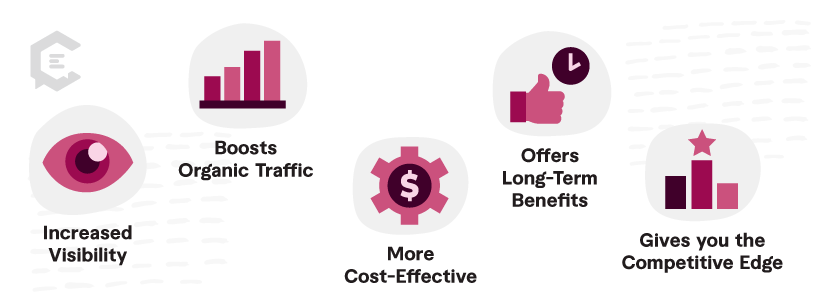What is search engine optimization (SEO)?
Search engine optimization is a set of on-site and off-site strategies to improve visibility and rankings on search engine results pages (SERPs). SEO aims to attract organic (non-paid) traffic from search engines like Google, Bing, or Yahoo.
SEO is absolutely essential if you intend to grow traffic or even just get your website in front of the right audience. It’s all about making your website findable in search at the right times for the right search terms. With SEO, there are tactics to perform on your website (like title tags) and off your website (like link building).
Although performing a few SEO tactics might increase traffic, putting them together ensures you don’t leave any leads on the table. Think of SEO like a spoked wheel, where the spokes are all SEO tactics. If you start taking out spokes, you weaken the wheel.
Why is SEO important?
Without SEO, your website is an undiscoverable island in the middle of an ocean of content. By incorporating SEO into your content marketing strategy, you maximize your reach and attract valuable customers to your products and services. Search engine optimization also leads to the following:
Increased Visibility: When your content appears on the first page of search results, more users are likely to find and engage with it.
Boosts Organic Traffic: By optimizing your content for relevant keywords, you attract users actively seeking information related to your products or services.
More Cost-Effective: Once your content ranks well, it continues to attract visitors without spending money on paid advertising.
Offers Long-Term Benefits: Well-optimized content can maintain its ranking and visibility over time, providing consistent traffic and leads.
Gives you the Competitive Edge: By outranking competitors in search results, you have a better chance of attracting customers and growing your market share.
On-page SEO tactics
When it comes to SEO, you need a strategy that includes on-page and off-page optimization. On-page optimization is a series of tactics you incorporate on your site to create a better user experience and increase your search visibility.
On-page optimization tactics include:
Optimizing title tags and meta descriptions
Using optimized, descriptive content headings (H1, H2, etc.)
Using optimal content length
Optimizing your images
Using SEO-friendly URLs
Uploading a sitemap to Google Search Console
Using both internal and external contextual links where appropriate and advantageous
Making sure your website is fast enough so users don’t bounce
Off-page SEO tactics
Off-page optimization is a great way to enhance your website’s credibility by optimizing your presence through external sources. Here are some essential elements to incorporate into your strategy.
Link building
Creating profiles on relevant social media channels
Creating a Google My Business listing and keeping it up-to-date
Collaborations with influencers or industry experts
Encourage satisfied customers to leave positive reviews and testimonials
Guest blogging to build backlinks and position yourself as an expert in your field
On-page SEO, off-page SEO, and content strategy work together to create the best possible plan for increasing traffic, leads, and sales. If you’re doing all these things together, you have the best strategy in place. If you’re trying to do one without the others, gaining traffic and business is much harder.
Incorporating SEO Keywords
Standard SEO practice in the past used keywords as many times as possible on a page to rank in search. Thankfully, the search engines picked up on this spamming tactic and updated the algorithm to stop this behavior. If you overuse keywords, you will rank lower in search results. The history of SEO and keywords is complicated and worth learning.
The key to a great keyword strategy is to start with researching top search terms in your industry. If you want the most bang for your buck, invest your efforts in long-tail keywords to maximize your SEO efforts.
SEO Link building strategies
Link building is another SEO tactic that has evolved steadily and is no longer a spammy practice. There are many link-building myths out there which can harm your brand’s reputation. The quality of your backlinks is just as important as the quantity. Quality backlinks drive more traffic to your site and boost your credibility in your industry.
Create High-Quality Content: Focus on producing valuable and relevant content that others want to link to.
Guest Blogging: Guest blogging lets you showcase your expertise and gain backlinks from authoritative sources.
Broken Link Building: Identify broken links on other websites and offer your content as a replacement. It’s a win-win, as you get a backlink, and the website owner fixes a broken link.
Resource Link Building: Resource pages attract backlinks from websites seeking authoritative content.
Monitor and Disavow Bad Backlinks: Regularly check your backlink profile and disavow any low-quality or harmful links. Google’s Disavow Tool helps you remove undesirable backlinks.
Take your SEO game to the next level
Incorporating SEO is absolutely essential to your marketing strategy and the success of your business. Modern search tools root out bad actors who try to game the algorithm with spammy keywords, backlinks, and low-quality content. You need high-quality, original content that converts to establish yourself as an authority in your industry.
ClearVoice knows how to maximize your SEO strategy, from keyword research to optimized content, to help increase your rankings, traffic, and conversions. Talk to a content specialist at ClearVoice today to make the most of your SEO.






